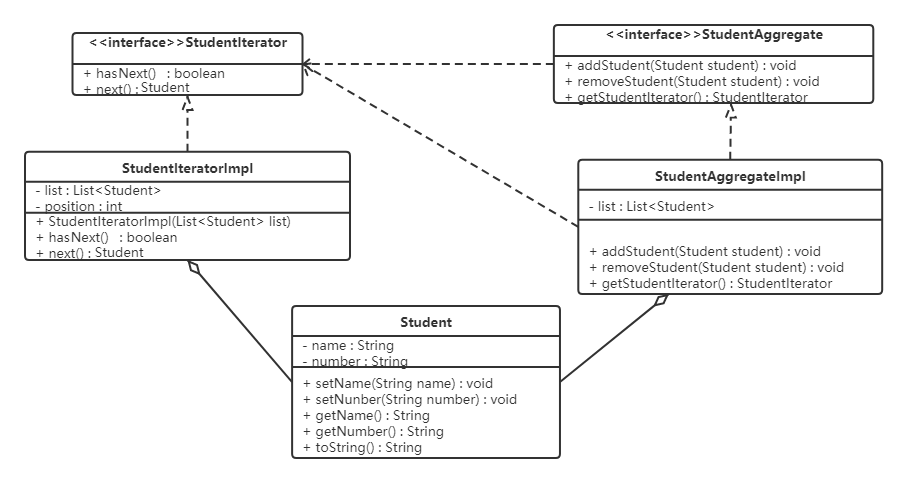-
迭代器设计模式
迭代器模式
1 概述
定义:
提供一个对象来顺序访问聚合对象中的一系列数据,而不暴露聚合对象的内部表示。
2 结构
迭代器模式主要包含以下角色:
-
抽象聚合(Aggregate)角色:定义存储、添加、删除聚合元素以及创建迭代器对象的接口。
-
具体聚合(ConcreteAggregate)角色:实现抽象聚合类,返回一个具体迭代器的实例。
-
抽象迭代器(Iterator)角色:定义访问和遍历聚合元素的接 口,通常包含 hasNext()、next() 等方法。
-
具体迭代器(Concretelterator)角色:实现抽象迭代器接口中所定义的方法,完成对聚合对象的遍历,记录遍历的当前位置。
3 案例实现
【例】定义一个可以存储学生对象的容器对象,将遍历该容器的功能交由迭代器实现,涉及到的类如下:

代码如下:
定义迭代器接口,声明hasNext、next方法
public interface StudentIterator { boolean hasNext(); Student next(); }- 1
- 2
- 3
- 4
定义具体的迭代器类,重写所有的抽象方法
public class StudentIteratorImpl implements StudentIterator { private List<Student> list; private int position = 0; public StudentIteratorImpl(List<Student> list) { this.list = list; } @Override public boolean hasNext() { return position < list.size(); } @Override public Student next() { Student currentStudent = list.get(position); position ++; return currentStudent; } }- 1
- 2
- 3
- 4
- 5
- 6
- 7
- 8
- 9
- 10
- 11
- 12
- 13
- 14
- 15
- 16
- 17
- 18
- 19
- 20
定义抽象容器类,包含添加元素,删除元素,获取迭代器对象的方法
public interface StudentAggregate { void addStudent(Student student); void removeStudent(Student student); StudentIterator getStudentIterator(); }- 1
- 2
- 3
- 4
- 5
- 6
- 7
定义具体的容器类,重写所有的方法
public class StudentAggregateImpl implements StudentAggregate { private List<Student> list = new ArrayList<Student>(); // 学生列表 @Override public void addStudent(Student student) { this.list.add(student); } @Override public void removeStudent(Student student) { this.list.remove(student); } @Override public StudentIterator getStudentIterator() { return new StudentIteratorImpl(list); } }- 1
- 2
- 3
- 4
- 5
- 6
- 7
- 8
- 9
- 10
- 11
- 12
- 13
- 14
- 15
- 16
- 17
- 18
- 19
4 优缺点
1,优点:
- 它支持以不同的方式遍历一个聚合对象,在同一个聚合对象上可以定义多种遍历方式。在迭代器模式中只需要用一个不同的迭代器来替换原有迭代器即可改变遍历算法,我们也可以自己定义迭代器的子类以支持新的遍历方式。
- 迭代器简化了聚合类。由于引入了迭代器,在原有的聚合对象中不需要再自行提供数据遍历等方法,这样可以简化聚合类的设计。
- 在迭代器模式中,由于引入了抽象层,增加新的聚合类和迭代器类都很方便,无须修改原有代码,满足 “开闭原则” 的要求。
2,缺点:
增加了类的个数,这在一定程度上增加了系统的复杂性。
5 使用场景
- 当需要为聚合对象提供多种遍历方式时。
- 当需要为遍历不同的聚合结构提供一个统一的接口时。
- 当访问一个聚合对象的内容而无须暴露其内部细节的表示时。
6 JDK源码解析
迭代器模式在JAVA的很多集合类中被广泛应用,接下来看看JAVA源码中是如何使用迭代器模式的。
List<String> list = new ArrayList<>(); Iterator<String> iterator = list.iterator(); //list.iterator()方法返回的肯定是Iterator接口的子实现类对象 while (iterator.hasNext()) { System.out.println(iterator.next()); }- 1
- 2
- 3
- 4
- 5
看完这段代码是不是很熟悉,与我们上面代码基本类似。单列集合都使用到了迭代器,我们以ArrayList举例来说明
- List:抽象聚合类
- ArrayList:具体的聚合类
- Iterator:抽象迭代器
- list.iterator():返回的是实现了
Iterator接口的具体迭代器对象
具体的来看看 ArrayList的代码实现
public class ArrayList<E> extends AbstractList<E> implements List<E>, RandomAccess, Cloneable, java.io.Serializable { public Iterator<E> iterator() { return new Itr(); } private class Itr implements Iterator<E> { int cursor; // 下一个要返回元素的索引 int lastRet = -1; // 上一个返回元素的索引 int expectedModCount = modCount; Itr() {} //判断是否还有元素 public boolean hasNext() { return cursor != size; } //获取下一个元素 public E next() { checkForComodification(); int i = cursor; if (i >= size) throw new NoSuchElementException(); Object[] elementData = ArrayList.this.elementData; if (i >= elementData.length) throw new ConcurrentModificationException(); cursor = i + 1; return (E) elementData[lastRet = i]; } ... }- 1
- 2
- 3
- 4
- 5
- 6
- 7
- 8
- 9
- 10
- 11
- 12
- 13
- 14
- 15
- 16
- 17
- 18
- 19
- 20
- 21
- 22
- 23
- 24
- 25
- 26
- 27
- 28
- 29
- 30
- 31
- 32
- 33
这部分代码还是比较简单,大致就是在
iterator方法中返回了一个实例化的Iterator对象。Itr是一个内部类,它实现了Iterator接口并重写了其中的抽象方法。注意:
当我们在使用JAVA开发的时候,想使用迭代器模式的话,只要让我们自己定义的容器类实现
java.util.Iterable并实现其中的iterator()方法使其返回一个java.util.Iterator的实现类就可以了。 -
-
相关阅读:
Linux学习第15天:Linux设备树(二):枝繁叶茂见晴天
我的写作心得
初见物理引擎库Cannon.js(2)
性能指标详解
Netty系列教程 Netty组件之EventLoopGroup
管件注塑过程中采用串级PID控制法实现高压压力精密控制的解决方案
公司招了个五年经验的测试员,见识到了真正的测试天花板
深度自编码网络的集成学习ICPS入侵检测模型
VR家居为什么盛行?可以解决哪些传统家居的痛点?
Kotlin面向对象
- 原文地址:https://blog.csdn.net/qq_43459116/article/details/125569022
